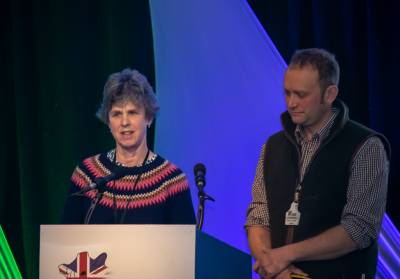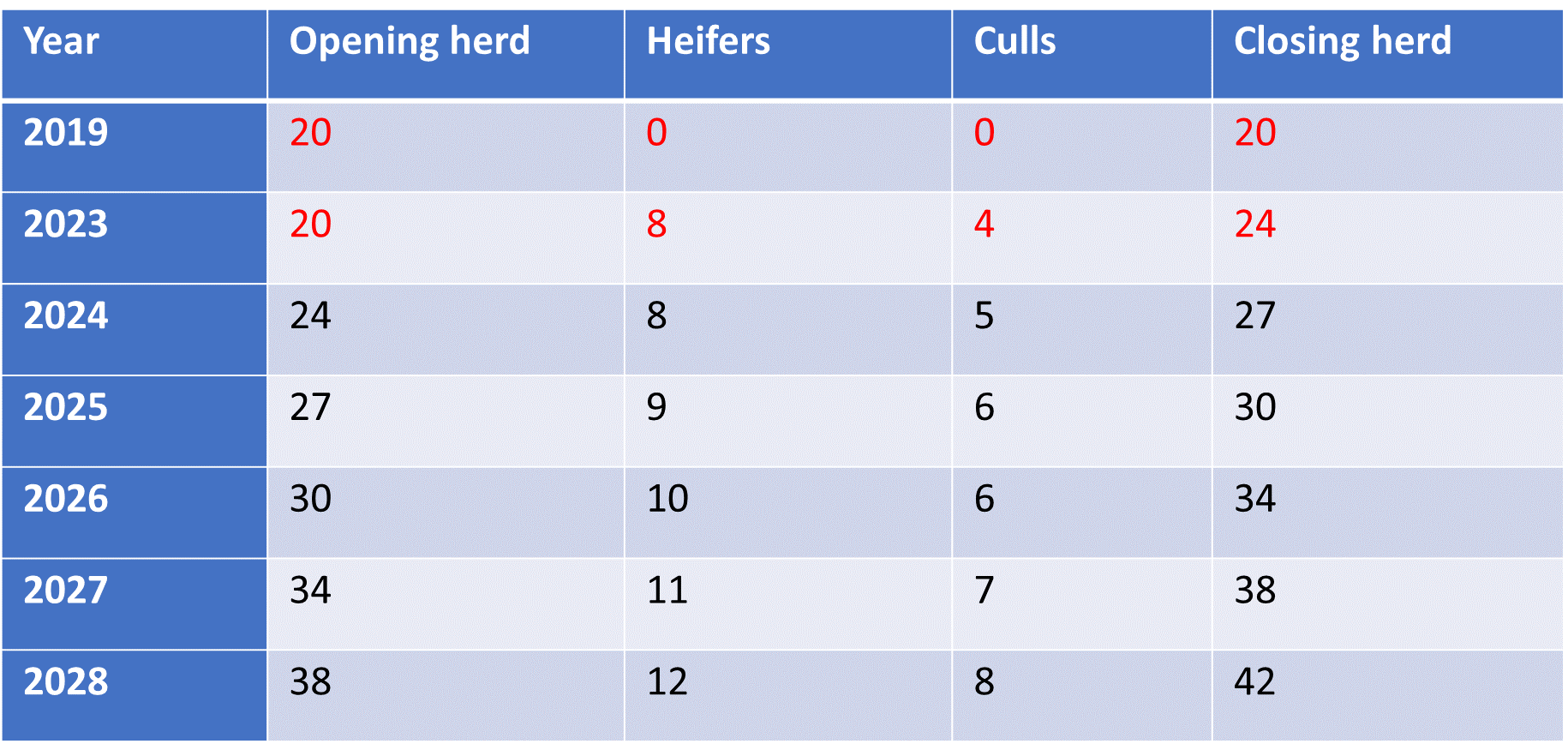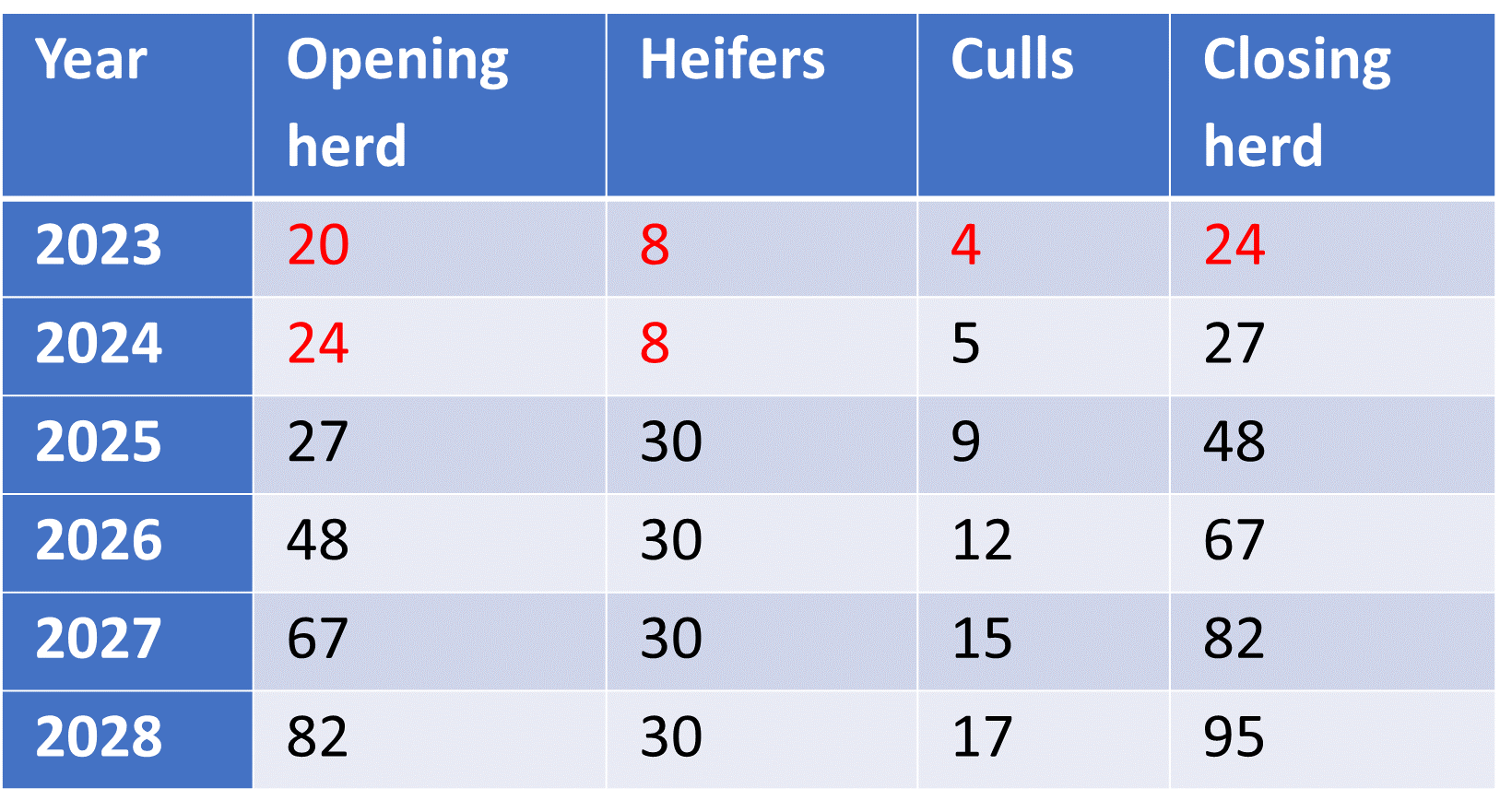
Background
I went back to the tenanted family farm in 1995 which was 250 acres, milking 80 Holstein Friesian cows and growing 120 acres of cereals. My mother had taken over the management of the farm in the 1970’s after my father had had a serious head injury - juggling a full-time job outside of the farm as well as bringing up two children.
After leaving school, I had led a fairly nomadic work life completely unrelated to farming, however in the 1990’s my father’s health started to deteriorate further, and the decision was made that I would go back and run the farm.
In 1999 I was given a 20yr FBT. I was fortunate in one way in that my mother gave me carte blanche in how to take the farm forward. I didn’t enjoy growing cereals, being beholden not only to the weather but also to the whims of contractors, so I worked hard at increasing the cows yield with a simple silage/maize diet, but found the profits were still hard to come by.
Our consultant Gerard Finnan (FCG) took a group of us over to Ireland in 2001 to see several spring block calving farms and a light bulb moment flashed when I saw how having a simple grass-based herd could not only improve my work/lifestyle balance but increase profitability by concentrating on keeping costs under control. Also, at this time I joined ‘Gillingham Grazers’ discussion group which was just being established.
We blocked up our AYR calving non-extreme Holstein Friesians to calve in the autumn of 2002, calved nothing in 2003 when we served everything to NZ jerseys and started block spring calving in 2004, only having crossbred calves from then on.
We gradually decreased the cereals as we increased the herd to 300 using our own replacements from our more fertile cows. Back then there were no crossbred heifers to buy, but this meant that we kept the good genetics we had within the herd- and more importantly increased profitability.
Nathan came to work for us part-time whilst he was at college at Kingston Maurward then full-time after leaving college in 2010.
In 2015 Nathan was keen to further his knowledge of spring calving systems so went to New Zealand for the calving period. The decision was made in spring that year to go once a day milking - partly because cow numbers were increasing, and the yard space and parlour was inadequate, and partly because I would be doing most of the work with occasional temporary staff during the time that he was away.
Once a day milking was very successful and probably caused more anguish for the management than the cows which after the second day didn’t look to come out of the paddock in the afternoon.
My FBT ended in September 2019 and despite my numerous efforts to engage with the landlord with plans to invest in a new parlour and bring an antiquated farm into the 21st century, at my own cost, they were always turned down. So, the decision was made to try and find a new farm.
New Farm
In September 2018 I took on a 10yr FBT at Alford Fields, Lovington, a 500 acre farm about 12 miles from the old farm. The cows moved whilst they were dry in December 2018 and January 2019 and the young stock stayed at the old farm until the summer 2019.
We transferred our milk contract with Barbers Cheesemakers - we were moving closer to the factory, so they were more than happy especially as we produce high solids milk that is ideal for cheese making.
The new farm had been quite run down and neglected though it did mean that it was a blank canvas for us. Monies were borrowed from the bank to put in a new 40/80 swing over parlour, associated equipment for 400 cows and for the general infra-structure of water troughs, fencing paddocks and tracks.
Works for this started in November 2018 and were almost ready by the time that we started calving in February 2019!
This was then an opportunity for Nathan to invest in cows and help him build up his capital within the business, which was something that we had been discussing for some time. We bought 50 in calf heifers from one source of which Nathan bought 20 - this enabled us to be milking 400 in the spring of 2019. We reverted back to twice a day milking purely because it aided cash flow whilst re-paying the debt.
Team - The team now comprises of myself, Nathan, 1 full-time, 2 part-time and an apprentice.
We involve all the team by having weekly breakfast meetings, where grass allocation, cow performance and KPI’s that the team can influence are discussed. Everyone is encouraged to attend discussion group meetings, so that they benefit from getting off farm and seeing other farms.
All have a training course of their choice every year paid for by the business.
Full time employees work a five day week (40-45hrs) and everyone has every other weekend off.
All are paid a salary so that they can budget and not lose out during the dry period when hours per week are less.
Both of us are learning to deal with more staff. We enjoy having people that are keen to learn and progress. Experience we find is not essential as we can train people if they have an open mind and have a ‘can-do’ manner. We also try to have an apprentice, which sometimes can be challenging but seeing them gain confidence and progress is very rewarding.
Farm Technical Data
- Cows are dried off 20th Dec and planned start of calving is 25th February
- Calving 411 in 2023
- 180 followers
- Cows weighed annually in July
- Young stock weighed at birth then regularly through to calving to ensure on target to calve in at 450kgs
- Aiming for a 500kg mature cow producing 500kg milk solids from 500kg concentrate
- Current average (2021) 513kg cow produced 475kg milk solids from 600kg concentrate
- Dry cows/Heifers out wintered on stubble turnips or loose housed on Hay/Silage Bales
- Young stock out wintered on deferred grass and silage bales
- Milk Recording and Johnes tested quarterly
- 2022 was the first year of using Sexed Semen. The herd was ranked for milk solids produced as a percentage of their body weight. The range varied from producing 141% to 50%
- The top 20% were served to sexed semen
- The middle 60% were served to conventional dairy
- The bottom 20% including all Johnes cows were served to easy calving Hereford/Angus/BB
Breeding is kept simple; if it looks like a Friesian, it’s served to either a Jersey or Crossbred and if it looks like a Jersey served to a Friesian- Just to maintain a 500kg cow.
All mating decisions are made prior to the breeding season and coloured coded onto a chart next to the AI flask.
2020 - 12% empty in 12 weeks
2021 - 12% empty in 10 weeks
2022 - 10% empty in 9 weeks (52% conception for SS, 60% conventional)
Target - 10% or under in 9 weeks
Succession
Firstly, I looked up the opposite of succession and found the words:
- Disagreement
- Decline
- Dispute
- Repudiation
Without any forethought to succession this is all too common, and definitely not what I wanted after working hard to build up a resilient business.
I then looked up the definition of succession and found that a successor is a person that takes on a job or position after someone else - this sounded infinitely more attractive and a way to encourage the next generation into farming. I followed this train of thought further and discovered the difference between inheritance and succession.
‘Inheritance is the process of an heir inheriting from ancestors’ BUT that ‘succession governs how the inheritance takes place’
This is something that should take place well before the event in order that the business can move forward with confidence financially and not be put at risk whilst issues arise regarding differences of opinions.
Initial Succession plan
I pay Nathan a monthly cow hire charge for each of his cows in the herd.
I look after Nathan’s cows as my own, i.e. Feed/Vet/AI costs and I have the value of the milk from them.
If they are sold either as cull cows or in calf out of the 9 week block, Nathan gets the value of them.
When they calve, I get the value of the calf.
If it’s a dairy calf Nathan has the option to buy it back.
This is a rearing fee from weaning to calving (22 mths) which is paid monthly by Nathan to aid his cashflow.
Initial Plan

Table 1 Shows that working on a 15% replacement rate year on year and buying only the heifer calves from Nathan’s own cows he would not reach his target of owning 100 cows by 2028
We have recently reviewed and updated the initial plan after having a meeting with Phil Cooper (FCG) in order to find a path that suited us both.
New Plan

Table 2 Still working on a 15% replacement rate Nathan will have to purchase a larger number of heifers per year to be in the position that he wants to be by the end of the tenancy. He is now looking at various ways to finance this.
Future Business Structure
Plan A - would be for Nathan to take on tenancy at Alford Fields, we have already put the seed of thought to the Landlord- If this happens, Nathan would become a director of the company with me leaving money within the business for a return for my retirement.
Plan B - Would be to sell up at the end of the tenancy. I then retire and Nathan has options either to take on his own tenancy elsewhere, go share/contract farming or find another investor to go in partnership with.
Plan C - Would be to move farms again and keep a similar structure to plan A
With all these plans the key is to keep an open mind and continue networking with as many people as possible to be ready not if but when a gate opens.
Catherine’s Objectives
Short term - To get the new farm up and running as quickly and as profitably as possible. I needed to concentrate more on the business enterprise and needed someone reliable and knowledgeable to take on the day to day management of the herd and it seemed to me that the best way of ensuring this and also for Nathan to achieve his goals was for him to have a financial interest within the business.
Medium term - is for me to step back and for Nathan to take on more responsibility, not only with the day-to-day management but also involve him in the meetings regarding the financial management of the business.
Long term - is to have the option to retire at the end of 2028 and to tick a few things off the bucket list.
Nathan’s Objectives
Short Term - To grow cow numbers by buying heifer calves from own cows. He has taken the ‘Focussed Farmers’ & ‘Entrepreneurs in Dairy’ courses.
Medium Term - To own 100 cows and be in a position to take on my own FBT.
Long Term - 2nd Unit whether that be share/contract farming or another FBT.
Catherine’s Lessons Learned:
- Always use a facilitator when discussing future plans- A business plan is needed to include the ambitions and goals of both parties.
- Be willing to delegate, but not too quickly- so not to overwhelm the successor.
- Be aware that mistakes will be made along the learning process.
Nathan’s Lessons Learned:
- Only buy in animals when absolutely necessary - no matter how good the genetics they never last as long as home bred animals.
- Start buying calves sooner to get to aid cash flow and to get to goal sooner.
- Be open- minded and embrace change- Goals and plans develop along the way.
Take Home Messages
- Start the process early and communicate openly.
- Use a facilitator to ensure that both parties have to the chance to share their goals and objectives - these should be written down and form part of the business plan- so that no misunderstandings creep in at any stage. They can be and should be updated along the way.
- Surround yourself with the right people- nothing can beat belonging to a good discussion group and having excellent mentors to help and question your choices and decisions.
- And last of all be confident that your successor is capable of managing business - you may well be relying on them to generate an income for your lifestyle in the future.
Photography Credit @Jenny Wood Photography